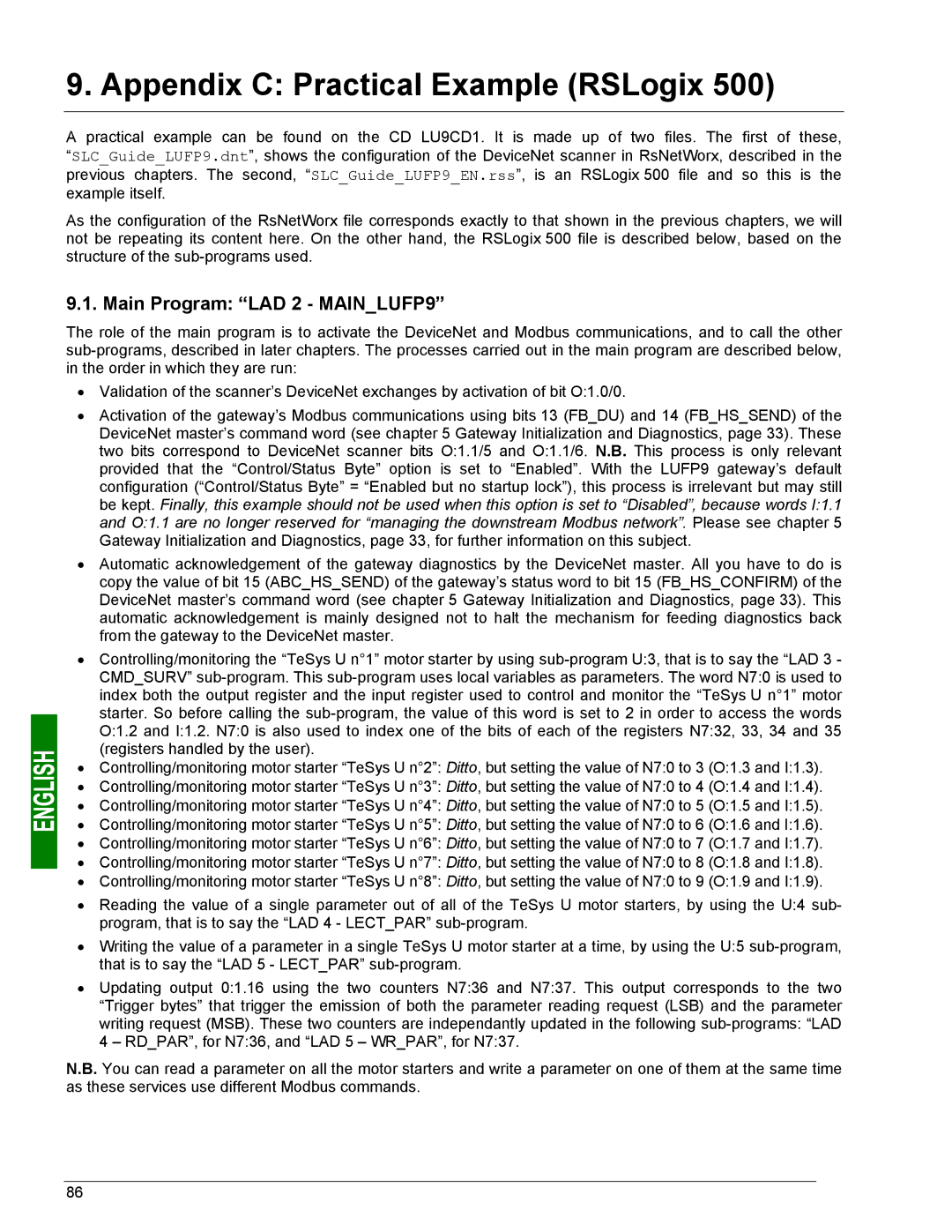
9. Appendix C: Practical Example (RSLogix 500)
A practical example can be found on the CD LU9CD1. It is made up of two files. The first of these, “SLC_Guide_LUFP9.dnt”, shows the configuration of the DeviceNet scanner in RsNetWorx, described in the previous chapters. The second, “SLC_Guide_LUFP9_EN.rss”, is an RSLogix 500 file and so this is the example itself.
As the configuration of the RsNetWorx file corresponds exactly to that shown in the previous chapters, we will not be repeating its content here. On the other hand, the RSLogix 500 file is described below, based on the structure of the
9.1. Main Program: “LAD 2 - MAIN_LUFP9”
The role of the main program is to activate the DeviceNet and Modbus communications, and to call the other
•Validation of the scanner’s DeviceNet exchanges by activation of bit O:1.0/0.
•Activation of the gateway’s Modbus communications using bits 13 (FB_DU) and 14 (FB_HS_SEND) of the DeviceNet master’s command word (see chapter 5 Gateway Initialization and Diagnostics, page 33). These two bits correspond to DeviceNet scanner bits O:1.1/5 and O:1.1/6. N.B. This process is only relevant provided that the “Control/Status Byte” option is set to “Enabled”. With the LUFP9 gateway’s default configuration (“Control/Status Byte” = “Enabled but no startup lock”), this process is irrelevant but may still be kept. Finally, this example should not be used when this option is set to “Disabled”, because words I:1.1 and O:1.1 are no longer reserved for “managing the downstream Modbus network”. Please see chapter 5 Gateway Initialization and Diagnostics, page 33, for further information on this subject.
•Automatic acknowledgement of the gateway diagnostics by the DeviceNet master. All you have to do is copy the value of bit 15 (ABC_HS_SEND) of the gateway’s status word to bit 15 (FB_HS_CONFIRM) of the DeviceNet master’s command word (see chapter 5 Gateway Initialization and Diagnostics, page 33). This automatic acknowledgement is mainly designed not to halt the mechanism for feeding diagnostics back from the gateway to the DeviceNet master.
•Controlling/monitoring the “TeSys U n°1” motor starter by using
• Controlling/monitoring motor starter “TeSys U n°2”: Ditto, but setting the value of N7:0 to 3 (O:1.3 and I:1.3).
• Controlling/monitoring motor starter “TeSys U n°3”: Ditto, but setting the value of N7:0 to 4 (O:1.4 and I:1.4).
• Controlling/monitoring motor starter “TeSys U n°4”: Ditto, but setting the value of N7:0 to 5 (O:1.5 and I:1.5).
• Controlling/monitoring motor starter “TeSys U n°5”: Ditto, but setting the value of N7:0 to 6 (O:1.6 and I:1.6).
•Controlling/monitoring motor starter “TeSys U n°6”: Ditto, but setting the value of N7:0 to 7 (O:1.7 and I:1.7).
•Controlling/monitoring motor starter “TeSys U n°7”: Ditto, but setting the value of N7:0 to 8 (O:1.8 and I:1.8).
•Controlling/monitoring motor starter “TeSys U n°8”: Ditto, but setting the value of N7:0 to 9 (O:1.9 and I:1.9).
•Reading the value of a single parameter out of all of the TeSys U motor starters, by using the U:4 sub- program, that is to say the “LAD 4 - LECT_PAR”
•Writing the value of a parameter in a single TeSys U motor starter at a time, by using the U:5
•Updating output 0:1.16 using the two counters N7:36 and N7:37. This output corresponds to the two “Trigger bytes” that trigger the emission of both the parameter reading request (LSB) and the parameter writing request (MSB). These two counters are independantly updated in the following
N.B. You can read a parameter on all the motor starters and write a parameter on one of them at the same time as these services use different Modbus commands.
86
